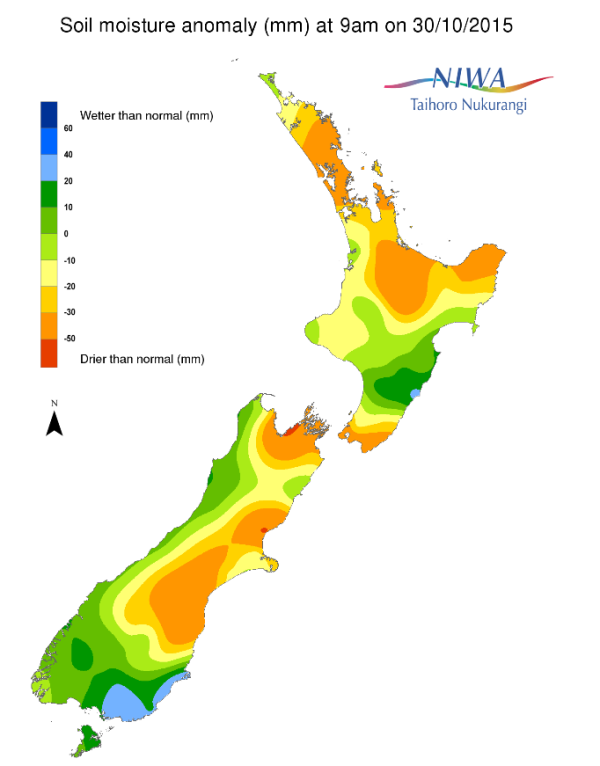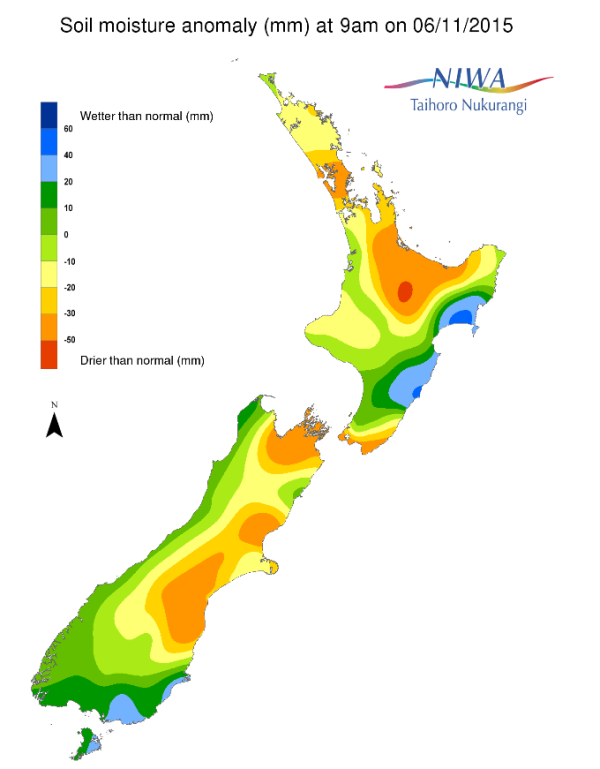A weekly update describing soil moisture across the country to help assess whether severely to extremely dry conditions are occurring or imminent.
Regions experiencing these soil moisture deficits are deemed “hotspots”. Persistent hotspot regions have the potential to develop into drought.
Facts: Soil Moisture
For the North Island, soil moisture levels have changed very little when compared to this time last week. The exception to this is the southern Gisborne and Hawke’s Bay regions which received abundant rainfall this week from a deep low pressure system, bringing soil moisture to above normal levels for this time of year. Soil moisture in Manawatu-Wanganui is also tracking well and remains in the near normal range for the time of year. The driest soil are in the north-eastern Waikato to Bay of Plenty regions where soil moisture levels decreased compared to this time last week and are much drier to severely drier than normal for this time of year. The Auckland and southern Wellington regions are also drier than normal for the time of year.
In the South Island, soil moisture levels have likewise remained largely unchanged compared to last week. Soil moisture levels east of the Divide from eastern Tasman down to northern Otago are drier than normal for the time of year while the remainder of the island continues to experience near normal soil moisture conditions (and slightly wetter than normal soils about Invercargill). Soil moisture levels are severely drier than normal for the time of year in parts of Nelson and Marlborough as well as in the districts of coastal Hurunui, Waimakariri, Timaru, Waimate and eastern parts of the Mackenzie country.
Outlook
For the North Island, it’s looking like a very dry week ahead with frontal rain bands moving towards New Zealand largely falling apart before reaching the North Island. Although these disintegrating fronts will bring intermittent showers on Monday and possibly Thursday, rain accumulation for the week as whole will be very minimal. As a result, soil moisture levels are expected to decrease for the entire North Island throughout the week.
The South Island is also in for a dry week. Although there is a low approaching Southland on Saturday afternoon, this is expected to fall apart very quickly and only bring steady rain to Southland and the lower West Coast. Beyond the weekend, the dominance of high pressure will provide very little opportunity for rainfall with only one weak front expected to roll through mid-week. Because of this, soil moisture levels are likely to decrease across the entire South Island over the next week and intensify the dryness already present in hotspot regions as well as expanding their extent.
Overall, a hotspot persists from southern sections of east Canterbury with another hotspot located in north-central parts of eastern Canterbury, roughly north of Christchurch to the Waiau River. A new hotpsot now exists in eastern Marlborough. For the North Island, while hotspot areas do not exist, areas in the southeast Waikato to Bay of Plenty as well as east of the Tararua ranges and south of Masterton are being watched for possible hotspot development.
Background:
Hotspot Watch a weekly advisory service for New Zealand media. It provides soil moisture and precipitation measurements around the country to help assess whether extremely dry conditions are imminent.
Soil moisture deficit
The amount of water needed to bring the soil moisture content back to field capacity, which is the maximum amount of water the soil can hold.
Soil moisture anomaly
The difference between the historical normal soil moisture deficit (or surplus) for a given time of year and actual soil moisture deficits.
Dry and extremely dry soil
Definitions: “Extremely” and “severely” dry soils are based on a combination of the current soil moisture status and the difference from normal soil moisture.
Check out NIWA's soil moisture maps
Soil Moisture Anomaly Maps
Pictured below soil moisture anomaly maps, relative to this time of year. The maps compare last week’s soil moisture anomaly with today’s.


